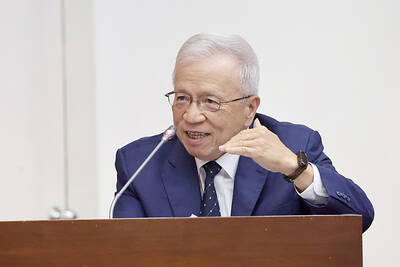The data transmission speed of 6G (sixth-generation wireless) networks is expected to be 10 to 100 times faster than 5G technology, MediaTek Inc (聯發科) said in a paper released on Jan. 18.
6G standardization is expected to begin in 2024 or 2025, with the first standard technology expected in 2027 or 2028, said MediaTek, one of the world’s leading chip design companies.
“Our 6G vision is of an adaptive, integrated and super heterogeneous wireless communication system, delivering pervasive mobile connectivity in a truly ubiquitous manner,” the paper said.

Photo: Grace Hung, Taipei Times
The sector is making breakthroughs in the research and development (R&D) of key 6G technologies, said Fan Ming-xi (范明熙), deputy general manager of MediaTek’s communication system design department.
MediaTek is bolstering its 6G R&D and is working with top-end researchers in academia and industry to explore innovative technology trends, Fan said.
In addition to several new technologies, such as ultra-wideband receiver and transmitter technology, the convergence of terrestrial and non-terrestrial networks, artificial intelligence, and machine learning for networking and communications could lead to more innovative and emerging technologies being introduced over the next few years, Fan added.
The standardization and rollout of 6G technology would follow the timeline set out in the International Telecommunication Union Radiocommunication Sector’s International Mobile Telecommunications vision for 2030 and beyond, MediaTek said.
The company expects initial standardization efforts to start next year or in 2024.
It said it would continue to develop 5G technology to help push the standardization and commercialization of 6G systems.
MediaTek also outlined new “killer applications” for 6G technology, saying these would drive the need for higher performance, such as extreme holographic and tactile communications, digital twins and advanced telepresence.
MediaTek said that 6G technology could cause data transmission speeds to rise by a factor of 10 to 100, with guaranteed low latency relative to 5G, and provide additional spectrum availability in the 7 to 24 gigahertz and sub-terahertz frequencies, with total addressable bandwidth of 50 gigahertz.
The new spectrum opens up significant opportunities to deliver “extreme applications,” but also creates significant challenges, such as overcoming poor propagation at higher frequencies, the paper said.

JITTERS: Nexperia has a 20 percent market share for chips powering simpler features such as window controls, and changing supply chains could take years European carmakers are looking into ways to scratch components made with parts from China, spooked by deepening geopolitical spats playing out through chipmaker Nexperia BV and Beijing’s export controls on rare earths. To protect operations from trade ructions, several automakers are pushing major suppliers to find permanent alternatives to Chinese semiconductors, people familiar with the matter said. The industry is considering broader changes to its supply chain to adapt to shifting geopolitics, Europe’s main suppliers lobby CLEPA head Matthias Zink said. “We had some indications already — questions like: ‘How can you supply me without this dependency on China?’” Zink, who also

At least US$50 million for the freedom of an Emirati sheikh: That is the king’s ransom paid two weeks ago to militants linked to al-Qaeda who are pushing to topple the Malian government and impose Islamic law. Alongside a crippling fuel blockade, the Group for the Support of Islam and Muslims (JNIM) has made kidnapping wealthy foreigners for a ransom a pillar of its strategy of “economic jihad.” Its goal: Oust the junta, which has struggled to contain Mali’s decade-long insurgency since taking power following back-to-back coups in 2020 and 2021, by scaring away investors and paralyzing the west African country’s economy.

Taiwan Semiconductor Manufacturing Co (TSMC, 台積電) received about NT$147 billion (US$4.71 billion) in subsidies from the US, Japanese, German and Chinese governments over the past two years for its global expansion. Financial data compiled by the world’s largest contract chipmaker showed the company secured NT$4.77 billion in subsidies from the governments in the third quarter, bringing the total for the first three quarters of the year to about NT$71.9 billion. Along with the NT$75.16 billion in financial aid TSMC received last year, the chipmaker obtained NT$147 billion in subsidies in almost two years, the data showed. The subsidies received by its subsidiaries —

BUST FEARS: While a KMT legislator asked if an AI bubble could affect Taiwan, the DGBAS minister said the sector appears on track to continue growing The local property market has cooled down moderately following a series of credit control measures designed to contain speculation, the central bank said yesterday, while remaining tight-lipped about potential rule relaxations. Lawmakers in a meeting of the legislature’s Finance Committee voiced concerns to central bank officials that the credit control measures have adversely affected the government’s tax income and small and medium-sized property developers, with limited positive effects. Housing prices have been climbing since 2016, even when the central bank imposed its first set of control measures in 2020, Chinese Nationalist Party (KMT) Legislator Lo Ting-wei (羅廷瑋) said. “Since the second half of